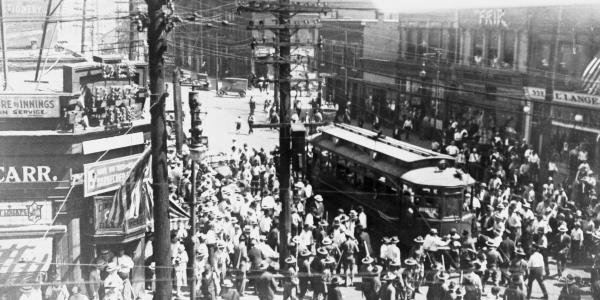Historian Douglas Flowe recounts the stories of two eruptions of racialized violence against African Americans by revenge-seeking white mobs in the early 20th century.
In the summer of 1900 Arthur J. Harris, a recent black migrant to New York City’s Tenderloin neighborhood, confronted plainclothes policeman Robert Thorpe as he attempted to arrest his girlfriend on the street. Unaware Thorpe was a police officer, Harris fatally slashed him with a blade during the confrontation. As news of the incident spread through Manhattan, white residents descended upon black blocks, tenement buildings and establishments seeking revenge.
The New York Tribune compared the ensuing riot to similar recent violence in the South: “It was a scene on very much the same order as took place a few days ago in New-Orleans…. The shouting of the men, the shrieking of the women, the lamentations of the children, the shooting of the revolvers and crashing of windows all made a perfect pandemonium.” Raging mobs stopped and assaulted black citizens on sidewalks, dragged them from streetcars and pummeled them on the asphalt. A white bystander later recalled “a squad of police” that “marched up the street and made a demonstration against every negro in sight.” Likewise, a police officer and a mob of more than 50 people clubbed Harry L. Craig unconscious in the street. “The officers led the crowd,” Craig recounted, “and did not interfere when others were beating me.” Only a sudden rain shower early the next morning stopped the rioting for a day, but fighting returned a number of times over the next couple of years.
In the wake of the initial carnage, black and white commentators articulated scathing indictments of police and white rioters and formed the Citizens’ Protective League to “punish their assailants” and follow through on indictments. Some black residents packed up and left the ramshackle housing of central Manhattan and began an exodus to newly built constructions in Harlem, where they would create a more racially exclusive black mecca over the next few decades. And others responded with bricks, bottles and guns to protect their neighborhoods and businesses, defend themselves and launch counter-offensives.Seventeen years later, similar lawlessness erupted in East St. Louis, Illinois, and a correspondingly lopsided exchange took place that forced black migrants to adapt on rocky terrain. Like many industrializing cities, St. Louis and the surrounding area had received thousands of African-American migrants each week in the spring of 1917 seeking better paying jobs and improved housing, and fleeing Jim Crow restrictions and violence farther south. Following a long list of labor-related riots across the country, the conflict in East St. Louis flared as striking white laborers blamed black newcomers for threatening their bargaining power against exploitative industrial managers, and they decided to take their anger out on men, women and children. At one point more than 3,000 white men ravaged black sections of the city by destroying buildings and killing nearly 200 residents by some estimates.
Much like black New Yorkers, black East St. Louisans responded to the rioting defensively and offensively when possible, and some began an exodus to other cities of the Midwest and North, hoping to land someplace safer. Nationwide, blacks called for federal actions against racial violence and questioned the meaning of American democracy. Within days Marcus Garvey declared it was “a time to lift one’s voice against the savagery of a people who claim to be the dispensers of democracy,” while New York City’s NAACP organized a silent protest march in solidarity with East St. Louis’ black residents.
Migration from south to north invariably involved black migrants in a process of becoming that included new freedoms to participate in a likely prosperous commercial economy through prospects of industrial and service employment. Yet it also thrust them into the fast-shifting meteorology of urban racial politics, and compelled the usage of old and new modes of coping, resistance and collective action. Far from isolated, the rioting in East St. Louis represented a peak in instances of such violence. Like the Tenderloin riot did for black New Yorkers, East St. Louis caused a moment of black national simultaneity and had a part in shaping the subsequent New Negro movement and self-defense ideologies of the 1920s and beyond.
Although separated by nearly two decades, when considered together these two events represent important nodes on a continuum of racial violence and black resistance and adaptation in migration. Both incidents illustrate the circumstances migrants faced in industrializing urban centers in the early 20th century and provide a model for understanding the interplay and exchange that interregional movement enacted.
Struggling to remake their lives after migration, blacks faced unwelcoming conditions, discrimination and the constantly simmering threat of large-scale public racial attacks. Arriving in hostile urban centers, they often found themselves scrambling to respond to the unpredictable terrain of racial war zones. Looking back from 2017 we can see clearly: The explosion of unrest in East St. Louis in 1917 foreshadowed another century of violence and marginalization and presaged a continually shifting rocky topography for black urbanites, a landscape that unfortunately still requires the usage of old and new modes of coping, resistance and collective action 100 years later.







